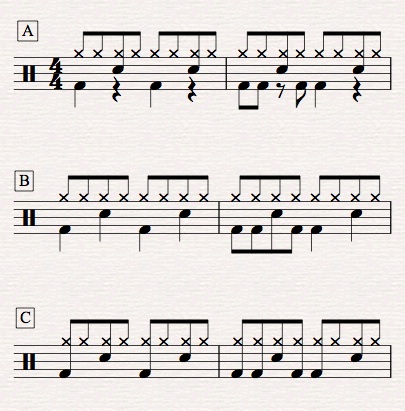
Before I continue, a quick comment on the different styles of fully notated drum parts.
There are 3 basic styles of notation for fully notated drum set parts that I’ve run across. They are shown at the top of this post. They are all perfectly valid and can be used to get the information to the drummer. As with all music notation the bottom line is, you want to strive to be clear and consistent. The style you use is up to you or may be dictated by the client or a specific situation.
Of these examples ‘A’ is the style I’ve always used. What I’m thinking when I notate is, drums and cymbals to be played with the hands are stems up, with the feet stems down. The rhythms are to be played are clear but there are are a lot more rests to keep up with. ‘B’ eliminates the rests and is also a very common notation style for drums. ‘C’ is a short hand that I have usually seen used by drummers who are writing charts for themselves. It is quick to write and doesn’t take up much space, excellent for a short hand style of writing.
The techniques I’ll cover in the next few blog posts can be applied to to any of these notation styles. As far as a reference for what line or space each instrument appears on, what notehead is used and other drum set notation considerations, I refer to the book “Guide to Standardized Drumset Notation” by Norman Weinberg. It is a thorough, well researched and well thought out reference. There are a few minor points I don’t quite agree with but on the whole I think it’s an excellent reference. Drum set notation is one of those areas like chord symbols that vary regionally, by genre and/or by the arranger or composer’s training. I fear we will never see a 100% agreement on all the details. But as I’ve said before if you strive to be clear and consistent you’ll find most musicians will give you what you need.
Hinch
Hinch!
Thanks so much for your time in publishing these explanations of drum parts, “from the arrangers mouth,” They are all very insightful to me as a player.. Just knowing that these are the last notes you create is particularly interesting because of course, they are the first ones I will read. Much obliged!
vb
This is great! Thanks for this.